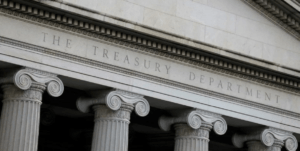Foreign Investors Cut U.S. Treasury Holdings Amid Rising Yields & Inflation Fears
Foreign holdings of U.S. Treasuries declined to $8.513 trillion in December from $8.633 trillion in November, with Japan and China leading the reductions. Japan’s holdings dropped to $1.060 trillion, while China’s fell to $759 billion, reflecting shifting investment strategies. The decline coincided with a surge in Treasury yields, driven by expectations of stronger economic growth and potential inflation following Donald Trump’s election victory. Additionally, the Federal Reserve signaled fewer interest rate cuts in 2025 due to persistent inflation concerns, influencing investor sentiment. As a result, global markets are closely monitoring U.S. economic policies and central bank decisions, which will shape future Treasury investment trends.

Foreign Investors Cut U.S. Treasury Holdings Amid Rising Yields & Inflation Fears
In December, foreign investors reduced their holdings of U.S. Treasury securities, marking a decline from the previous month. The decrease was primarily driven by Japan and China, the two largest foreign holders of U.S. government debt, both of which scaled back their investments. According to data released by the U.S. Department of the Treasury on Tuesday, total foreign holdings of U.S. Treasuries fell to $8.513 trillion in December, down from $8.633 trillion recorded in November. This decline follows a peak of $8.679 trillion in September.
Japan, which remains the largest foreign investor in U.S. Treasuries, reduced its holdings to $1.060 trillion, compared to $1.087 trillion in November. Meanwhile, China, ranked as the second-largest holder, trimmed its Treasury portfolio to $759 billion from $768.6 billion the previous month. These reductions reflect broader trends in international financial markets, where shifts in economic policies and expectations of inflation influence investment decisions.
During December, U.S. Treasury yields experienced a sharp rise, driven by investor anticipation of stronger economic growth and potential inflationary pressures. This sentiment was largely shaped by market expectations regarding policy measures under the new administration of Donald Trump, following his victory in the November presidential election. Analysts noted that proposals related to tariffs and immigration reforms contributed to a reassessment of the economic outlook, prompting investors to adjust their portfolios accordingly.
Additionally, the Federal Reserve played a key role in shaping market dynamics. Policymakers at the U.S. central bank, during their December meeting, signaled that they foresee fewer interest rate cuts in 2025 than previously anticipated. Their stance was influenced by persistent concerns about inflation, leading them to adopt a more cautious approach to monetary easing. The expectation of higher interest rates typically reduces the appeal of government bonds, as rising yields can make existing bonds less attractive to investors.
The reduction in foreign holdings of U.S. Treasuries highlights broader trends in global investment flows. Japan’s decision to lower its exposure may reflect efforts to diversify its reserves or respond to domestic economic conditions. Similarly, China’s continued divestment from U.S. government debt aligns with its long-term strategy of reducing reliance on dollar-denominated assets. Trade tensions and geopolitical considerations have also contributed to China’s gradual decrease in U.S. Treasury holdings over the years.
Despite these declines, the overall demand for U.S. government securities remains strong, supported by a diverse range of investors. While foreign central banks and sovereign wealth funds play a significant role, domestic institutions and private investors also contribute to market stability. The resilience of U.S. Treasuries as a safe-haven asset ensures continued interest, even amid shifting economic policies and global uncertainties.
As the year progresses, financial markets will closely monitor policy developments in the United States, particularly regarding fiscal measures, trade policies, and interest rate decisions. Investors will assess how these factors influence inflation, growth prospects, and the attractiveness of U.S. government bonds. Any changes in the Federal Reserve’s monetary stance, alongside geopolitical events, could further impact foreign investment in Treasuries.
In summary, December saw a decline in foreign ownership of U.S. Treasury securities, driven by reductions from Japan and China. The rise in Treasury yields, fueled by expectations of economic expansion and inflation concerns, contributed to these investment shifts. Meanwhile, the Federal Reserve’s cautious outlook on interest rate cuts added another layer of complexity to market dynamics. Going forward, global investors will continue to evaluate economic policies and central bank decisions to navigate the evolving financial landscape.
Check out TimesWordle.com for all the latest news
You must be logged in to post a comment.